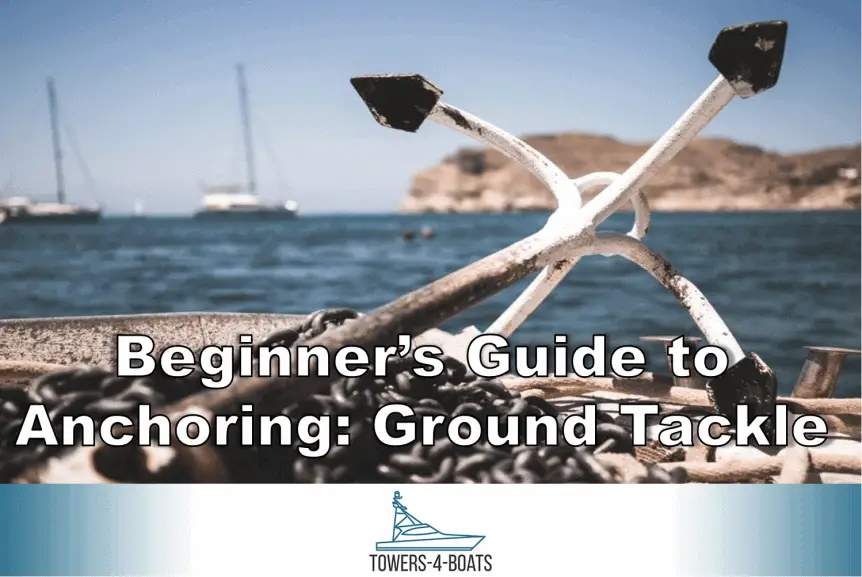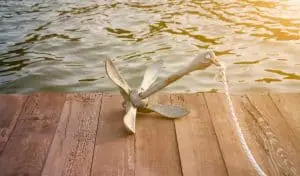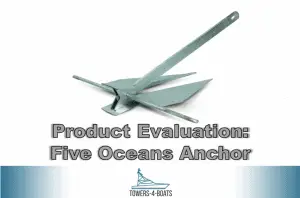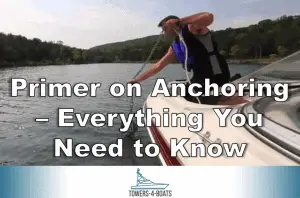The Best Anchors for Small Boats
Anchoring requires equipment that every boat should have. Even if you never plan on staying the night, an anchor is a necessary safety device. At the very least, you should have a folding anchor on nylon line ready at the bow should you need to stop the boat from drifting. Most owners of small boats don’t go beyond this phase.
This setup will do should the need arise, but if you’re thinking about heading out and spending some time on the hook, then you’ll want to put a little more thought and research into your ground tackle.
Many people focus solely on the anchor when considering their ground tackle. When going out to anchor, your ground tackle is an entire system of things stretching from your anchor on the bottom to the cleat that connects it to the deck. You may find my article on anchoring in wind helpful, too.
Chain vs. Nylon Rode
In a perfect world, everyone would use chain for their entire anchor system. Chain is heavier and sturdier than rope. It lays on the bottom and increases the holding power of your anchor, both from its weight and the shallower angle it creates as your boat pulls on the anchor. Boats riding on all-chain rodes can usually get away with 5:1 scopes, whereas the recommended minimum for a nylon rode is 7:1.
Chain is also abrasion-resistant. If you are anchoring in rocky areas or areas near coral, the chain cannot chafe. Sharp rocks can cut through nylon rode quickly.
But life is about compromises. As many advantages as chain has, there are disadvantages too. All that weight that helps your anchor hold also must be brought aboard. This will necessitate either an undesired workout every time you want to hoist anchor if you don’t have a windlass. A windlass is a manual or electric winch that helps you raise and lower the anchor.
The weight of the chain is also a problem for many boats. Small powerboats will not want to store so much load on their bows since doing so will affect the balance of the boat and reduce their trim.
Using Nylon as Anchor Line
Even if you use nylon rope as your primary anchor line, you will need some amount of chain. Having between 15 and 30 feet of chain attached directly to the anchor helps the anchor set in the bottom and stay put. It also provides protection by keeping the nylon away from the bottom. The chain will do the most moving and will not wear down like rope will.
Three-strand nylon is the most commonly used line for anchoring purposes. Eight-plait line is also sometimes used, especially if you are using a windlass.
Snubber or Bridles
One advantage of nylon is its springiness. It stretches, and when anchoring, that’s a good thing. When a gust of wind pulls the anchor line tight, nylon will stretch and give a bit, softening the load on your deck hardware.
Chain, on the other hand, is rock solid. When the line goes taut, a lot of force is put on your cleats or windlass. For this reason, you’ll want to use a snubber or bridle. A snubber is simply a length of nylon attached between the chain and a bow cleat so that when the boat pulls on its anchor line, the load is placed on the nylon line.
You can attach a snubber to the chain with a simple rolling hitch or with a special chain hook. Simple lifting hooks work, but many companies sell specialized snubber hooks specifically for the purpose that won’t fall off.
Bridles serve the same function but use a nylon line to each side of the bow. This distributes the load over two cleats. Catamarans nearly always use bridles because they help them ride better at anchor.
Splices, Shackles, and Swivels
Each different part of your anchor system must be tied together in a way to be assured it will not fail. Every time you use the anchor, look for any wear, chafe, missing pins, or signs of impending problems.
Between the anchor and the chain, a shackle must be used. Shackles should be high-quality load-tested models that are rated for the size chain and the loads to be expected. The pin should always be locked in place by a piece of stainless steel seizing wire.
Swivels can also be used between the anchor and chain, but their use is somewhat controversial. For one, swivels are not completely necessary, but they do add complexity. Their purpose is to keep the chain straight as it feeds into a windlass. They also allow the anchor to roll freely over the bottom, as it is designed to do to allow it to set.
If you don’t have a windlass or are using nylon rode, a swivel is likely not necessary. A trusty shackle will do.
Between the chain and the nylon rode, if there is any, the best connection is made with a rope to chain splice. This knot pulls itself tight and will not fail if done correctly. A shackle and bowline knot can also be used but is a poor substitute for a proper splice that introduces multiple points of possible failure.
Windlass
Windlasses can be simple manual units, or they can be electric. Electric windlasses are common on boats as small as 25-feet, especially when they use chain rodes.
The part of the windlass that feeds the rope and chain through it is called the gypsy. It must be sized exactly for your chain and rope combination. Chain-only gypsies are the most common, but there are a few chain and rope models available.
Anchor Designs
Not many topics get more dockside debate than anchors. Every boater has their preference.
Taken very generally, you can divide anchors into two camps. There are the classic designs that have been around for many, many years. And then there are modern designs that have recently been added to the mix. For every name brand, there are a dozen knock-off designs and brands with similar specs. No matter what an anchor manufacturer or their devotees may claim, all designs have limitations, and none will be suitable in every situation.
Classic anchors are time-tested designs like the Delta, CQR, Bruce, or Danforth brands. These designs are made for a specific type of bottom, and once they are set, they are designed to give maximum holding power in that bottom. Usually, these anchors depend heavily on the amount of weight to get their holding power.
The modern design ethos is slightly different. Manufacturers are now looking to make anchors that set in as many types of bottom as possible, making them more versatile. They are also trying to make anchors that set themselves. This is very handy if you are spending time at anchor, since if the wind shifts, they can be trusted, to some extent, to reset themselves. Examples of modern designs include Mantus, Rocna, and Spade. The shape of these anchors improves their holding power by utilizing their abilities to set deeply, and their weight is distributed unevenly to ensure they roll right-side up.
Popular Types of Anchors for Small Boats
Small boats need to weigh their options, both literally and figuratively. They usually require something that can be folded and stored easily, or kept on the bow roller. Danforth anchors are popular on nearly every vessel since they fold flat for storage and offer decent holding in many types of bottom. Boats with bow rollers have more options. Most vessels come standard with a Delta or similar plow-type anchor, with some owners choosing to upgrade to a newer option like a Rocna Vulcan or a Mantus.
Sizing Your Anchor
Among cruising vessels, the common advice is to say, “No one ever complained that their anchor was too big.” That’s very true if you live parts of your life at anchor, and it’s the most accurate statement ever spoken if you are at anchor in a storm.
But if you are just going out in fair weather for a swim and some lunch, you don’t need a huge anchor and all-chain rode. You must balance your need for security at anchor with the size of your bow roller and the weight you can safely load in the front of your boat when underway.
The anchor manufacturers provide sizing information with their various models. There is no hard-and-fast rule when sizing the anchor for your boat. Some designs rely more on weight, while others have a large footprint. Owners must decide what conditions they intend on using the anchor in, be it as a lunch hook or as a storm anchor. Most people who anchor a lot only agree on one thing. It’s best to take the manufacturers advice, and then go up one more size. Because no one ever complained about having too big an anchor.
Using Two Anchors
If your primary hook is a modern anchor that is designed to reset itself if pulled from the bottom, using two anchors is seldom necessary. If, however, you are anchoring in an area where you expect the wind or current to change dramatically and you do not trust your anchor to reset, you will need to put down multiple anchors. And if you are anchoring next to another boat that is on two anchors, then you will also need to put down two anchors.
There are two primary options for setting two anchors. The simplest way is to set one from the bow and one from the stern. This will keep the boat pointed in the same direction, regardless of current or wind, but it will move side to side as much as the anchor lines allow. When anchoring where space is limited, like on a narrow creek, this setup works well.
The other option is commonly called a Bahamian moor. Two anchors are set off the bow at a 45-degree angle, or more, to one another. This allows the boat to swing into the wind or current for a better ride. As the wind or current shifts, one line will go slack, and the other will tighten. This should keep the load generally linear on each anchor, reducing the chances an anchor will lose its set.
There are disadvantages to using two anchors, of course. For one, dealing with two lines can be a mess. With the Bahamian moor, it is possible that the lines twist around each other. Doing so can reduce the load capabilities of the line and take quite a while to sort out.
Also, be aware that your swing will be very limited with two anchors out. If the wind or tide changes, you will not move position very much while other boats riding on one anchor may move 200 feet or more. This makes a mess in busy anchorages when the wind changes. When deciding whether to drop one anchor or two, you must consider other boats and their swing.
Conclusion
Picking your anchor is a personal choice, and it’s one that boaters will find themselves making and rethinking as time goes on. It all balances on how you use your boat, where you anchor, and how long you stay.




